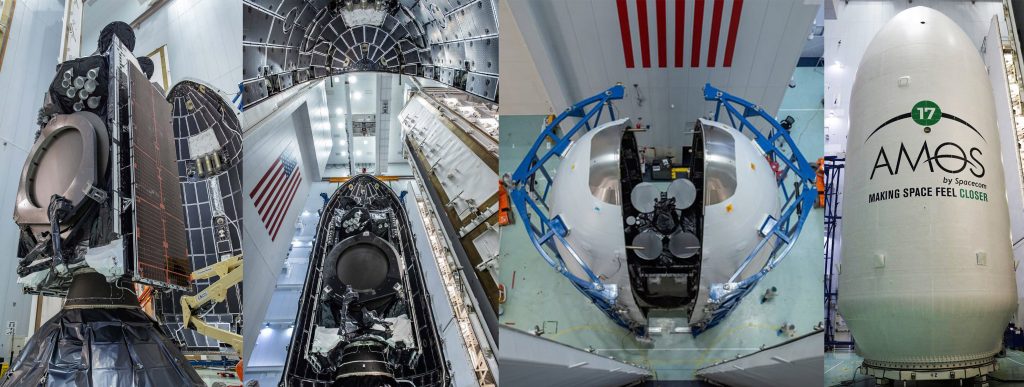Photos published on July 28th by customer Spacecom show a sooty SpaceX Falcon 9 booster and fresh upper stage on their way to LC-40 for the launch of the AMOS-17 communications satellite, scheduled to lift off no earlier than 6:51 pm EDT (22:51 UTC), August 3rd.
Sadly, the booster will reportedly be expended during the launch. According to Spacecom, AMOS-17 – built by Boeing – is an undeniably large satellite, weighing more than 6500 kg (14,300 lb) and featuring a solar array wingspan of ~35m (115 ft). SpaceX has certainly launched larger satellites than AMOS-17 and still recovered their Falcon 9 boosters, but this mission is somewhat unique and SpaceX is obviously willing to go the extra mile in this case.
In a surprise development, Spacecom officially confirmed that AMOS-17 will be SpaceX’s second expendable Falcon 9 Block 5 launch in the rocket’s ~15 months of operations, following in the footsteps of its expendable December 2018 launch debut. This is more than a little disappointing, thanks in large part to the fact that SpaceX has developed Falcon 9 (and Heavy) reusability to such a level of maturity that fully expendable Falcon launches just feel wrong.
In fact, just a month ago, SpaceX reached a major milestone of reusability when it recovered two flight-proven Falcon Heavy boosters and became the first company in history to launch and land more orbital-class rocket boosters than it has expended (as of June 2019: 81 launched, 43 landed). SpaceX followed this up with landing #44 after Falcon 9 B1056.2 successfully completed its second launch on July 25th.
While expending a Block 5 booster that SpaceX CEO Elon Musk has stated could launch upwards of 20-30 times is certainly disappointing, the sting of Block 5’s second expendable mission is at least soothed by the knowledge that it will be this booster’s third and final launch. The first expendable Block 5 launch – the US Air Force’s GPS III SV01 mission – made use of a brand new booster (B1054).
A (hopefully) worthy sacrifice
In a small way, Falcon 9 B1047’s premature demise could easily be viewed as a sort of symbolic eye-for-an-eye sacrifice. Although not a literal 1:1 replacement, AMOS-17 is still essentially a follow-on to Amos-6, destroyed on September 1st, 2016 when Falcon 9 suffered an exotic COPV failure that led to a massive explosion (Musk called it a ‘fast fire’).
Installed on top of the rocket during what was meant to be a pre-launch static fire test, the ~$200M+ Amos-6 satellite was not spared from the destruction and owner Spacecom ultimately received an insurance settlement it then used (in part) to purchase AMOS-17. Additionally, instead of accepting a cash payout from SpaceX, Spacecom chose the contractual alternative: a free Falcon 9 launch of their choice.
Is it a coincidence that a Block 5 booster is going to be expended as part of that replacement launch? Almost certainly, yes. At a minimum, SpaceX – essentially launching for free per a contractual agreement with Spacecom – has clearly decided along with Spacecom that putting all of Falcon 9’s energy into AMOS-17 is preferable to withholding margin for a landing.

With Falcon 9 B1047.2 in an expendable configuration, SpaceX can take a no-holds-barred approach towards delivering Spacecom’s AMOS-17 to the highest orbit possible. The higher the geostationary transfer orbit (GTO) Falcon 9 can launch AMOS-17 to, the faster the satellite can begin serving customers and thus generating revenue for Spacecom. Combined with the fact that more than half of AMOS-17’s massive 6.5-ton mass is chemical propellant, the spacecraft – pending a healthy launch and on-orbit commissioning – could be ready to start serving customers just a month or two after lift-off.
Falcon 9 B1047 will be missed, but the booster’s demise is an understandable cost of SpaceX prioritizing customer Spacecom’s launch experience above the company’s own best interests.
Check out Teslarati’s newsletters for prompt updates, on-the-ground perspectives, and unique glimpses of SpaceX’s rocket launch and recovery processes.

<!–
–>
var disqus_shortname = “teslarati”;
var disqus_title = “SpaceX transports Falcon 9 to launch site ahead of Block 5’s second expendable launch ever”;
var disqus_url = “https://www.teslarati.com/spacex-falcon-9-block-5-second-expendable-launch/”;
var disqus_identifier = “teslarati-110375”;

